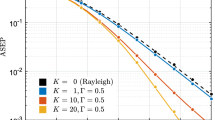Abstract
We investigate the use of the mean square error (MSE) transfer characteristics to examine the convergence behaviour of the iterative (turbo) multiuser detector for coded code-division multiple-access (CDMA) systems. Both MSE and mutual information (MI) based extrinsic information transfer (MSE-EXIT and MI-EXIT) chart techniques reveal the same asymptotic and convergence behaviours. An improved low complexity version of the soft interference cancellation MMSE (SIC-MMSE) detection scheme is also proposed for CDMA systems utilizing BPSK modulation. Herein, under fixed-point data representation and computation constraint a real time DSP implementation (using TMS320C6416) is suggested. EXIT charts reveal that fixed-point implementation is feasible at possibly no performance degradation. Based on the measured number of cycles of different constituent sub-functions of the proposed receiver, a data transmission rate of up to 186 Kb/s can be reached for a 5-users load and a processing gain of 7 in an AWGN channel.










Similar content being viewed by others
Notes
The term Conjugate is due to the fact that, \( {{\mathbf{r}}_k}\left( {i/i + 1} \right) \) and its conjugate \( {{\mathbf{r}}_k}{\left( {i/i + 1} \right)^* } \)are used.
Notice that this complexity can further be reduced if we assume that the channel is constant over the processed data block so that \( {{\mathbf{\bar{\Lambda }}}_k} = \frac{1}{M}\sum\limits_{i = 1}^M {{{\mathbf{\Lambda }}_k}(i)} \) is used instead of \( {{\mathbf{\Lambda }}_k}(i) \) and hence one matrix inversion is required per data block of M information bits (ergodicity assumption).
Notice that \( {{\mathbf{\Xi }}_{a,k}}(i) \) is a symmetrical matrix which admits real valued eigen values.
References
El Gamal, H., & Hammons, A. R. (2001). Analysis of turbo decoder using the Gaussian approximation. IEEE Transactions on Information Theory, 47(2), 671–686.
Bhattad, K., & Narayanan, K. R. (2004). An MSE based transfer chart to analyse iterative decoding schemes. 42nd Allerton Conf. on Communications, Control and Computing, Montelicello, IL, October 2004.
ten Brink, S. (1999). Convergence of iterative decoding. Electronic Letters, 35(13), 1117–1118.
ten Brink, S. (2001). Convergence behavior of iteratively decoded parallel concatenated codes. IEEE Transactions on Communications, 40, 1727–1737.
Shi, Z., & Schlegel, C. (2001). Joint iterative decoding of serially concatenated error control coded CDMA, IEEE Journal on Selected Areas on Communications, 19(6), 1646–1653.
Boutros, J., & Caire, G. (2002). Iterative multiuser joint decoding: unified framework and asymptotic analysis. IEEE Transactions on Information Theory, 48, 1772–1793.
Li, K., & Wang, X. (2005). EXIT chart analysis of turbo multiuser detection. IEEE Transactions on Wireless Communications, 4(1), 300–311.
Guo, D., Shamai, S., & Verdu, S. (2005). Mutual information and minimum mean-square error in Gaussian channels. IEEE Transactions on Information Theory, 51(4), 1261–1282.
Bhattad, K., & Narayanan, K. R. (2005). An MSE based transfer chart to analyse iterative decoding schemes. Available for download at: http://arxiv.org/PS_cache/cs/pdf/0506/0506058.pdf, June 2005.
Ahmed-Ouameur, M., & Massicotte, D. (2007). Real-time DSP and FPGA implementation of Wiener LMS based multipath channel estimation in 3G CDMA systems. Journal of VLSI Signal Processing Systems, 47(3), 259–279.
Wang, X., & Poor, V. (1999). Iterative (Turbo) soft interference cancellation and decoding for coded CDMA, IEEE Transactions on Communications, 47(7), 1047–1061.
Tuchler, M., Koetter, R., & Singer, A. C. (2002). Turbo equalization: principles and new results. IEEE Transactions on Communications, 50(5), 754–767.
Buzzi, S., Lops, M., & Tulino, A. M. (2001). A new family of MMSE receivers for interference suppression in asynchronous multiuser DS/CDMA systems employing BPSK modulation. IEEE Transactions on Communications, 49(1), 154–167.
Bhashyam, S., & Aazhang, B. (2002). Multiuser channel estimation and tracking for long code CDMA systems. IEEE Transactions on Communications, 50(7), 1081–1090.
Kehtarnavaz, N., & Kim, N. (2005). Real-time digital signal processing based on the TMS320C6000, 1st edition, Elsevier Inc.
Acknowledgements
The authors would like to thank the Axiocom Inc. and the National Science and Engineering Council of Canada (NSERC) for its financial support. We are grateful the anonymous reviewers critics as well.
Author information
Authors and Affiliations
Corresponding author
Rights and permissions
About this article
Cite this article
Ahmed-Ouameur, M., Massicotte, D. On MSE Exit Chart Analysis and Real Time DSP Implementation for Iterative (Turbo) Detection. J Sign Process Syst 64, 305–317 (2011). https://doi.org/10.1007/s11265-010-0489-2
Received:
Revised:
Accepted:
Published:
Issue Date:
DOI: https://doi.org/10.1007/s11265-010-0489-2




